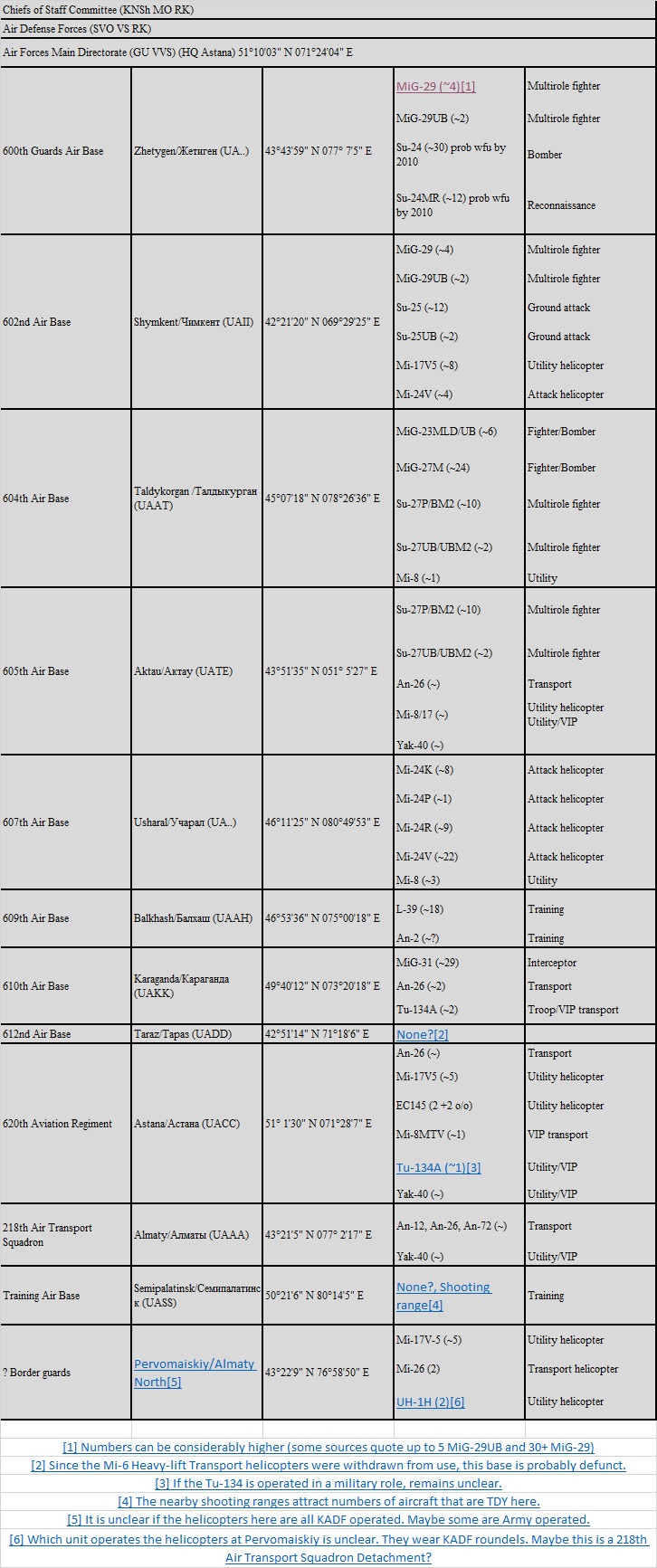Kazakhstan Air Defense Force (KADF)
Article and Photos by Patrick Roegies
Despite having an area larger than Western Europe and the second largest oil-reserves in the world, Kazakhstan is not the typical former Soviet Union country that springs to mind when we think of modern aviation, let alone a well-run air force. However, you may be surprised.
The Republic of Kazakhstan is a former Soviet Union nation which declared its independence on December 16, 1991. During the Soviet Era, Kazakhstan military resources were integrated in the Soviet Armed Forces under the Turkestan Military District, which disbanded on June 30 1992. With the newly gained independence, Kazakhstan faced the task of organizing their own air defenses.
Soviet Era
To get a clear picture on where Kazakhstan came from in terms of military aviation, the following Air order of Battle shows the Air Divisions and Independent Elements stationed on Kazakhstan soil which were under Soviet control.

After the end of the Afghan war in early 1989, many units returned to the Soviet Union. Some Russian units that used to be stationed in Poland and the former German Democratic Republic (DDR), were appointed to the Turkestan Military district. The 486th Independent Combat Helicopter Regiment equipped with Mi-8 ‘Hip’ and Mi-24 ‘Hind’ helicopters that were formerly based at Altes Lager in the DDR was one of the units that was relocated to Ucharal.
The troop withdrawal also initiated a reorganization in the Central Asian military District headquartered in the then-capital of Kazakhstan, Alma-Ata. The reorganization resulted in the formation of the Turkestan Military District which was only short-lived and was disbanded as soon as 1992, when the Kazakh military gained their independence.
The Russian Air Force (VVS) and Russian Air Defence Force (PVO) units of the 73rd Air Army based on Kazakh territory, would form the basis for the Kazakhstan Air Defense Force which even possessed 40 Tupolev Tu-95MS ‘Bear’ strategic heavy bombers. The Tu-95s appointed to the 37th Air Division were divided over two regiments, the 1223 Heavy Bomber Regiment and the 1226 Heavy Bomber Regiment, which were stationed at Dolon Chagan, west of Semipalatinsk in north-east Kazakhstan.
Shortly after the independence of Kazakhstan, aircraft deliveries constituted the biggest Russian arms transfers to Kazakhstan under the 1995 intergovernmental agreements on military and military-technical cooperation. This agreements covered the compensation for the withdrawal of Russian strategic arms Kazakhstan, among them the Tu-95MS bombers.
Since the Kazakh Air Force did not require this capability, the agreement included the exchange all of its strategic nuclear strike assets like the Tu-95s including their cruise missiles as well as a number of SS-18 and SS-20 medium range missiles. As a result the Tu-95s were relocated to the Engels and Ukrainka air bases in Russia. The ones that remained behind were eventually scrapped.
In the agreement Russia pledged to deliver 73 combat aircraft to Kazakhstan by the end of 1997. These deliveries consisted of: 21 MiG-21 ‘Fishbed’ fighters, 14 Su-25 ‘Frogfoot’ ground attack aircraft and 38 Su-27 ‘Flanker’ multi-role fighters. Initial deliveries of the first 43 were supposed to have taken place in 1995 and the remaining 30 aircraft in 1997. Of these, fourteen Su-25s were delivered in 1996. The initial delivery of four Su-27Ps and two Su-27UBs took place in 1996. At least four additional Su-27s were delivered in 1997 which were followed by another ten that were delivered between 1997 and 1998. According to several sources an additional 22 MiG-29 ‘Fulcrum’ fighters initially kept out of the agreement were acquired between 1995-1996[1].
In November 1999 another additional contract was signed for twelve additional Su-27s as a payment for Russia’s debts to Kazakhstan. Although further details concerning actual deliveries are unknown, it is estimated that the KADF had 38 single seat Su-27Ps and 8 dual seat Su-27UBs on strength in 2005.
A portion of the single-seat Su-27s that integrated in the KADF are presumably former PVO Su-27Ps which already served an operational life within the VVS’ 4th Air Army which was based at Stargard Szczeciński airbase in Poland. They were appointed to the 159th ‘Novorossiysk‘ Guards Fighter Regiment which wore red tactical ‘Bort’ codes and the 582nd Fighter Regiment from Chojna with blue Bort codes. When these regiments left Poland, the aircraft were initially reported to be relocated to the airbases Besovets and Smolensk and a couple of them were eventually adopted within the Kazakhstan Air Defense Force. Solid proof at least one former Stagard based Flanker that ended up in Kazakhstan is available.
Besides the aircraft included in the agreement an unknown number of fighter and reconnaissance aircraft, including MiG-23, MiG-27, MiG-25, Su-17 and Su-24 were transferred from the Russian inventory to the KADF. Many helicopters of different types saw the same fate and batches of Mi-6, Mi-8, Mi-17, Mi-24 and Mi-26 were also incorporated into the Kazakh inventory.
An important boost to the aerial interception role, was the acquisition of approximately 32 MiG-31 ‘Foxhound’ supersonic interceptor aircraft. Kazakhstan is the only nation to operate the MiG-31 besides Russia.
In the early days of the post-Soviet days, primary training was performed on a number of Yak-18T while the basic training was done with the L-39C ‘Albatros’. According to different estimates, eight to twelve L-39C trainers were transferred between 1996-2000. The main transport aircraft fleet consisted of a number of An-2s, An-12s and An-26s. In addition, Russia delivered one Il-76MD ‘Candid’ freight aircraft, one Tu-134Skh and one Tu-154B airborne command post.
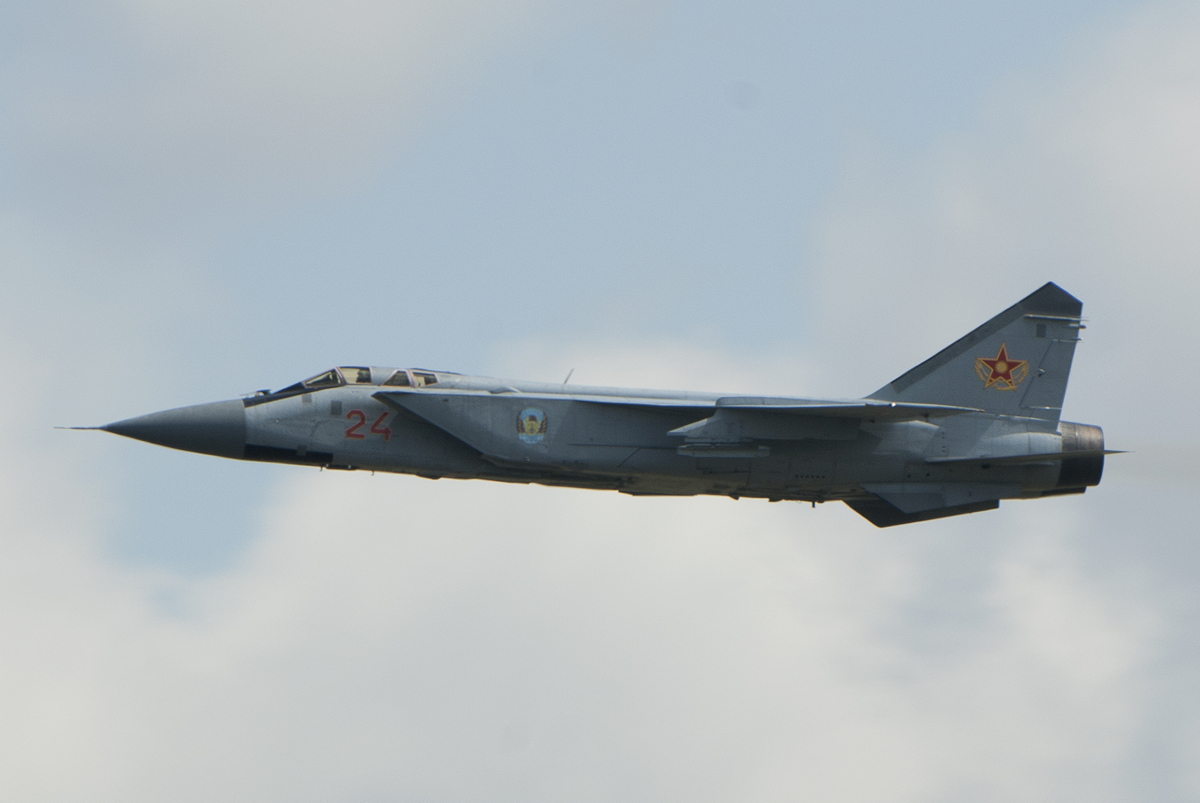
Mikoyan MiG-31 “Foxhound”
Restructuring
With the gained independence and the delivery of a functional inventory, Kazakhstan was left to its own devices to organize its own air defense forces. The acquired inventory was sufficient to form a functioning Air Force which was designated as “Sily Vozdushnoy Oborony Respubliki Kazakhstan‘ or Kazakhstan Air Defense Force (KADF). Its inventory was however primarily structured for air defense, possessing only limited strike capabilities, which deteriorated significantly since 1993 given the insufficient funds to keep this large inventory operational entirely.
To enhance the operational capabilities of the KADF, reorganizations commenced almost immediately and by late 1993 6 regiments and 1 additional Air Defense Fighter Regiment were formed. The 715th Mixed Fighter and Training Regiment based at Logovoya already consisted of two squadrons equipped with twelve MiG-29 ‘Fulcrum A’ (Izdeliye 9.12), and two MiG-29UBs as well as a number of MiG-23s. The MiG-29s were probably inherited from the former Soviet inventory in Kazakhstan. In 1995 an additional 22 MiG-29 were acquired and this delivery consisted of eighteen MiG-29 ‘Fulcrum A’ and 4 dual seat MiG-29UB. These MiG-29’s were probably based at Mary airbase in Turkmenistan before their transfer to the KADF.
Due to limited funds, the KADF was initially forced to greatly reduce the number of active aircraft. As a result most subtypes of the MiG-23 and MiG-27 (with the exception of the dual seat MiG-23UB and a few selected MiG-27s), were withdrawn from use or put in long-term storage. Until recently a total of approximately 100 MiG-23/27s used to be in long-term storage at Taldykorgan. A recent visit learned however, that all these aircraft have disappeared. It is unclear if they have been sold or scrapped altogether. When exactly the MiG-23’s were withdrawn from use remains unknown. During that same visit, a small number of Su-27s was noted, still sporting their original grey color scheme. This indicates that they were not upgraded after their delivery and have long been defunct.
According to unconfirmed sources, the 39th Mixed Reconnaissance Regiment at Balkhash, was decommissioned in 2000. It used to be equipped with thirteen MiG-25RBs, two MiG-25PUs and twelve Su-24MR. As a result, the MiG-25’s were withdrawn from use while the Su-24MRs were transferred to Zhetygen. The reduction also meant the end of the operational life of the Mi-6 fleet in 2001 and they have been stored at Taras Zhambul ever since. Also the entire Su-17 fleet was withdrawn from use in the mid-’90’s after the closure of Chimkent Air Base. The fate of the MiG-25’s, Su-17’s is unknown but most have probably been scrapped.

Mikoyan MiG-27K “Flogger”
Dealing with the remnants
Most of the MiG-21 aircraft had been in long term storage at Taldykorgan since 1990 but some squadrons remained operating the type until 1992. These were the 165th Mixed Fighter Regiment based at Emba and the Fighter Regiment at Ajaguz airbase. The last unit to operate the type was the 27th Guards Regiment at Ucharal and after it closed the final gates for the MiG-21 in operational life, it also sent its remaining aircraft to Taldykorgan for long-term storage. In a surprise move, however an estimated ten MiG-21bis and one dual seat MiG-21UM aircraft were reactivated again in 1999 and they served until 2003 for advanced pilot training purposes.
Scandal galore
During the late ’90’s the stored MiG-21s were the central topic of a number of scandals which lead to the resignation of the Minister of Defence and other government officials. In 1998, the Czech Agroplast Company committed itself to buy 40 MiG-21’s for $200,000 per MiG, while the Metallist company was the Kazakh counterpart to execute the contract. Under an October 1, 1998 agreement between the Kazakh Defense Ministry and Metallist, the fighters were transferred to the plant and a firm contract for the sale to Agroplast was signed on October 14, 1998. In March 1999 an An-124 heavy-lift transport aircraft carrying six dissembled MiG-21 fighters was embargoed at Baku IAP, Azerbaijan. Even though Bratislava was named as the official destination, there were suspicions that the planes could have been on their way to either North Korea or Bosnia. After an investigation the MiGs were returned to Kazakhstan and the An-124 released. This was not the end of the story because in the summer of 1999, 33 MiG-21 fighters were sent by rail transport from Taldykorgan to North Korea via China. This time the cargo arrived at the intended destination. A new scandal broke out, this time initiated by South Korea. North Korea flatly denied the importation of the fighters or any contacts with Kazakhstan on the issue and actual proof was never discovered.
On November 17, 1999 Kazakhstan’s intelligence service announced that its investigation into the illegal sale of the MiG-21 fighter aircraft to North Korea was completed and that senior government officials had been involved. The two scandals involving MiG fighters created huge embarrassment for President Nursultan Nazarbayev, who had worked hard to establish ties with the West.
Another case presented itself in March 2001. The Republic State Enterprise Kazspetsexport came in disrepute when they tried to sell 40 Su-27 multi-role fighters to Pakistan. Since 1999, Kazspetsexport had been planning to sell off the fighters for an estimated $4 billion. Since the sales of arms to Pakistan was under embargo and the number of aircraft intended was a substantial part of the KADF Su-27 fleet, actual deliveries did not take place.
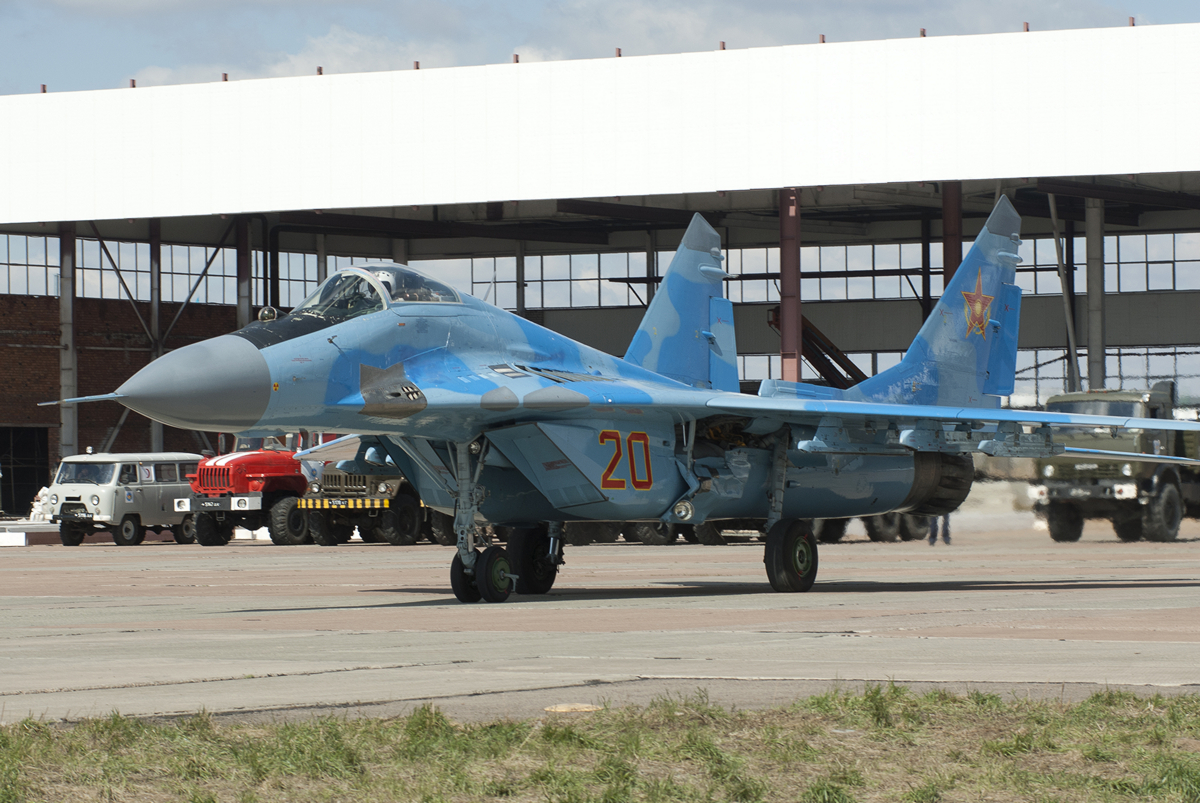
Mikoyan MiG-29A “Fulcrum”
Upgrades and acquisition time
The restructuring of the KADF that led to the current capabilities would not have been possible with a number of upgrade programs and new acquisitions. To get direct access to both Western and Russian hardware, the Kazakh government allowed the aviation industry to build a number of plants within the country.
Examples of these are the joint Russian-Kazakh venture company “Aviaremont” which is situated in Almaty. This factory started building helicopters and the number manufactured met the required number for the period between 2006-2009 which is estimated at 37 helicopters, including the delivery of 33 Mi-17s. In that same month a new agreement was drafted with Russia which covered the period of 2007 -2015. This agreement referred to the further cooperation for the production of helicopters. Initially limited to the Mi-17, but in the long run the entire line of Mil helicopters. A second example is the Eurocopter and Kazakhstan Engineering joint venture that resulted in an assembly and customization facility for Eurocopter EC145s in Astana.
On 11 January 2005, A Memorandum of Understanding (MOU) on the purchase of eighteen An-140-100 was signed. The MOU however did not result in an actual order. On 3 October 2005, the initial MOU was suspended but despite that, two airframes were acquired which were delivered early 2006.
The Mi-24 fleet has been submitted to a refurbishment program and initial deliveries of the modified Mi-24’s took place on 15 November 2005. The first four returned from Rostov on Don in Russia, where the aircraft were submitted to the upgrade program, which enabled the Attack helicopters to operate in day and night operations. In 2006 the refurbishment and upgrade of a further five Mi-24s was planned. Approximately 50 Mi-24 ‘Hind” helicopters in various subtypes were received.
In October of 2001, Ukraine stated the intention to develop a Military Technical Cooperation (MTC) with Kazakhstan. The cooperation would focus on repairing, refurbishing and modifying several types within the Kazakhstan Air Force. A MOU was signed for the modification of MiG-29s, Su-25s , Su-24s, and Su-27s, military-transport aircraft and helicopters (Mi-24 Mi-8, Mi-6 Mi-26).
Besides the modernization of aircraft in the Ukraine, Russia and Belarus were also involved in the modernization of the KADF inventory. An estimated total of twenty MiG-31s have been refurbished and upgraded in the 514th overhaul facility in Rzhev in Russia. The contract for the refurbishment of 10 MiG-31s was signed at the MAKS 2007 aerospace show. The refurbishment included a modernized and optimized high altitude flight capability, improved radar controls and cruise missile defence capabilities.
The MiG-23UBs and the L-39Cs have been refurbished and upgraded by AVIAVOENREMONT at Chuguev (Ukraine) while the MiG-27s and MiG-29s went to Lviv Aircraft Repair Plant (LSARP) in Ukraine for an extensive modernization program. At least twelve MiG-27s and fifteen MiG-29s have been upgraded. The Su-25’s followed the Su-27’s and were submitted to refurbishment at Zaporizhe Aircraft Repair Plant.
Between 2009 and 2011 at least two Heavy-Lift Mi-26 helicopters have been refurbished in Novosibirsk. The first Mi-26 was delivered after modification in 2009 and the second one very recently.
Another recently completed modernization is that of an An-12 turboprop transport aircraft has been refurbished and delivered to the KADF in November 2011. The upgraded aircraft has been fitted with a GPS navigation system, advanced weather detectors, and an altimeter. At least one An-12s has been noted in storage at Almaty Airport, however it is believed that additional aircraft will be submitted to a life extending modification program in due course.
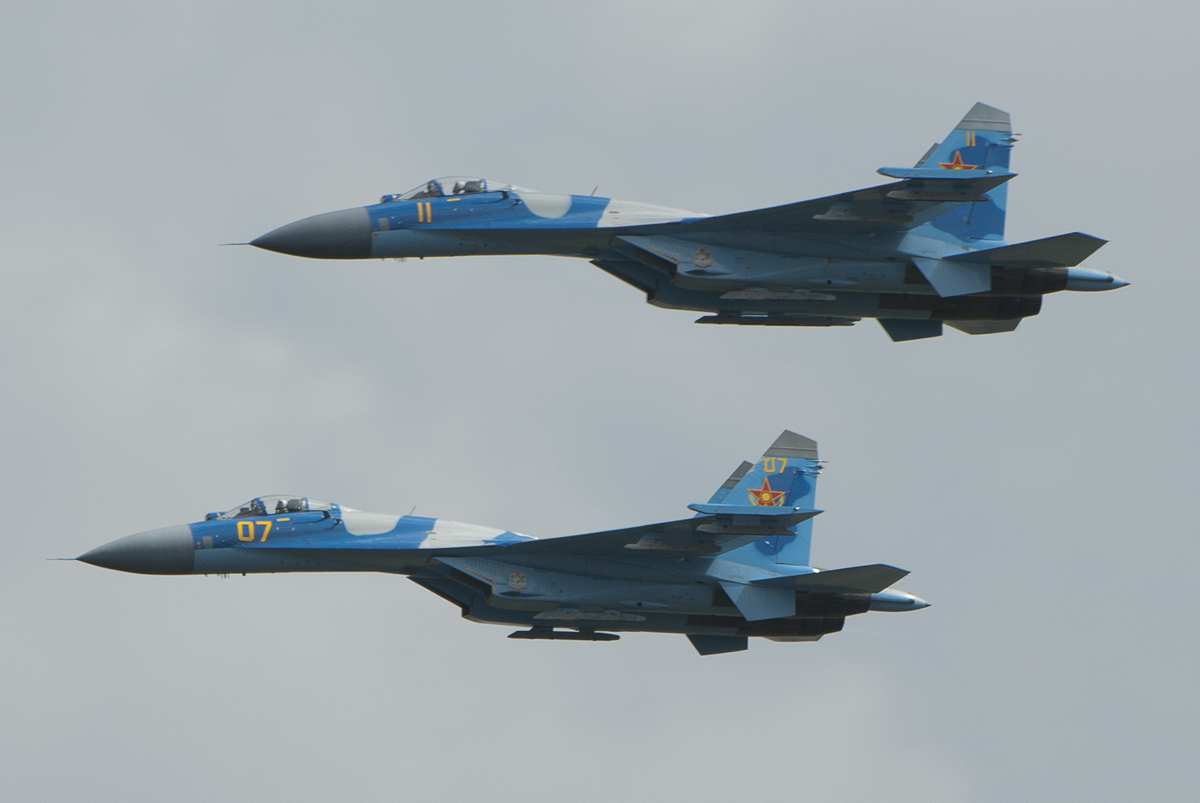
A pair of Sukhoi Su-27P “Flankers”
Fancy Fencers?
The exact status of the Su-24 ‘Fencer’ fleet remains unclear since there is little solid information available concerning deliveries and the status of the fleet. The only report form a delivery dates from 1995 when 4 Su-24s should have been delivered.
In the early 2000s, the Su-24 fleet was intended to be modernized at the Novosibirsk Aircraft Production Association but it remains unclear if these aircraft or a smell selection of aircraft were actually refurbished.
Another modernization program for the Su-24 fleet was announced on 6 February 2005. The ‘Hephaestus’ company is quoted to have participated in the modernization of the Su-24s at the beginning of 2006. Approximately 35 aircraft should have been submitted to an extensive overhaul program. Current details are sketchy but it is confirmed that Su-24s were operated until late 2009. It is unclear if the type is withdrawn from use altogether. Most, if not all of the Su-24s are currently in long time storage at Zhetigen, where besides 22 Su-24s, also thirteen MiG-29s were recently noted in long time storage.

Sukhoi Su-24 “Fencer”
Flankers, the multi-role backbone of the KADF
The KnAAPO and IAPO manufactured single seat Su-27 and 27UB dual seat ‘Flankers’ were also submitted to an extensive modernization program. In the time frame of 2005 to 2009 they received major overhauls at the 558th Aircraft Repair Plant in Baranovichi, Belarus as well as in Russia and in the Ukrainian Zaporizhzhia Aircraft Repair Plant. In 2009, the 558th Aircraft Repair Plant won a tender for the upgrade of ten KADF Su-27s to M2/UBM2 versions. The first two modernized aircraft (single seat Su-27M2 Bort “05 yellow” and dual seat Su-27UBM2 Bort “50 yellow”) were delivered to their home base of Taldykorgan, in December 2009. The upgrade program was completed by June 2010.
One of the major components of the upgrade is the Litening-III airborne day & night navigation and targeting pod produced in Israel by Rafael Advanced Defence Systems. The Su-27UBM2 received the Belarus-developed Satelite-M airborne X-band jammer as well as a modernized N001 fire-control radar system. It is unclear if only the 604th Air Base (Taldykorgan) Su-27’s received the upgrade or if all operational Su-27’s were upgraded. The initial contract with 558th Aircraft Repair Plant, dating from 2007 covered the upgrade of only ten airframes.
The two units operating the Su-27 in KADF service are 604th Air Base at Taldykorgan and 605th Air Base at Aktau in the south-west of the country. Both are believed to be part of the same “Barysy Zhetysu” (“Snow Leopards from Zhetysu“) Regiment since recent pictures show the distinctive snow leopard regimental badge on both the Aktau and Taldykorgan-based aircraft.
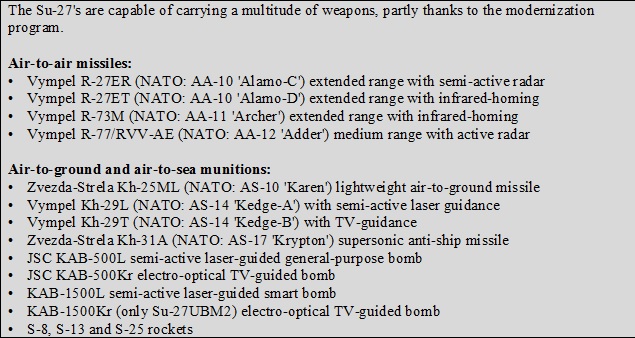
The KADF is expected to remain operationally viable in the near future. Recent upgrade programs of the Su-27 to Su-27M2 standard and the modifications of the MiG-27, MiG-29, MiG-31 and Su-25 all contribute in countering the deficiencies.
Primary training might be limited since the recent withdrawal from the Yak-18T. However, during KADEX 2012, a number of small “Lancair-like” types were demonstrated. The authors believe these aircraft play a role in the training syllabus of the KADF.
By withdrawing a moderate number of obsolete aircraft and concentrating the remaining resources on a handful of units the KADF has succeeded in acquiring and maintaining a serious airborne air defense capability. In September 2011 Colonel – General Valery Gerasimov presented the future plan for a joint air defense cooperation between Kazakhstan and Russia. Details of this cooperation remain unknown but according to several unconfirmed sources, future Kazakhstan Air Defense Force pilots and officers will be trained in Russia. Furthermore Kazakhstan has an Individual Partnership Action Plan with NATO and has strategic cooperation with the Turkish armed forces.
To boost the transport capability, the modernization of the Mi-26 heavy-lift helicopters and An-12 and An-26 medium transport aircraft were very welcome. Recently a contract was signed for the delivery of in total of six C-295 medium transport aircraft. The first two will be delivered early 2013 and will in due course replace the aging An-12 and An-26 fleets. The KADF also showed interest in acquiring new Yak-130UBS trainers for advanced pilot training and is looking for the possibilities to acquire the Su-35 fighter and the fifth generation PAKFA fighter.
During 2011, two EC145 utility helicopters were delivered to the KADF and during the defense exposition ‘KADEX 2012’, held in May 2012, the Kazakhstan government ordered another pair of EC145 helicopters for search and rescue missions which are to be assembled in-country by the Eurocopter Kazakhstan Engineering joint venture. For Eurocopter the KADEX 2012 venture was very successful because the government of Kazakhstan also signed a letter of intent to acquire 20 Eurocopter EC725 medium-lift rotorcraft. These aircraft, which will be assembled in Kazakhstan, will be used in a full range of mission applications.
During KADEX 2014 a Russian Air Force Su-30 was present and several high ranking officers were seen taking test flights. Early 2015 the first four Su-30’s were actually delivered to the Kazakhstan Air Defence Force.

A four ship of Sukhoi Su-27 “Flankers”
Conclusion
Kazakhstan is one of the former Soviet states that has proven to be very capable to build its own Air Defense Force and to upgrade and maintain it at a very high level. All the aircraft that have been seen in operational service in the last few years are in good or even pristine condition. The acquisitions of modern transport aircraft and helicopters will give a huge boost to the logistic capabilities of the armed forces. With an upgraded fleet and the basis is solid and with the commitment to train the pilots in order to meet NATO standards will result in a capable air defence force. With the intended cooperation with Russia pilot training will be expanded. Studies for the replacement for the existing force are already in progress in order to be well prepared for future replacements.
The KADF Air Order of Battle is presumably as follows:
